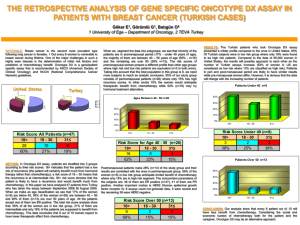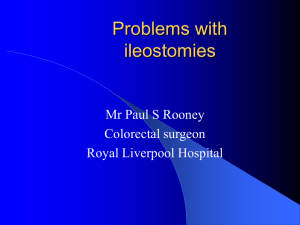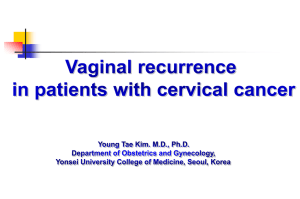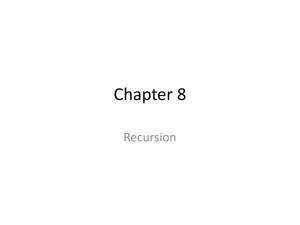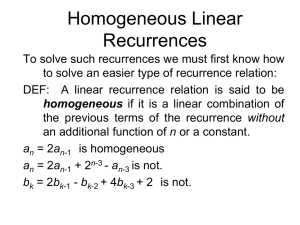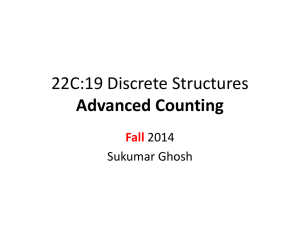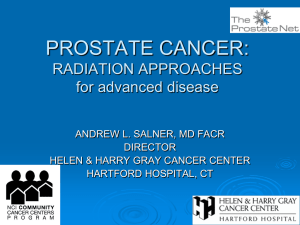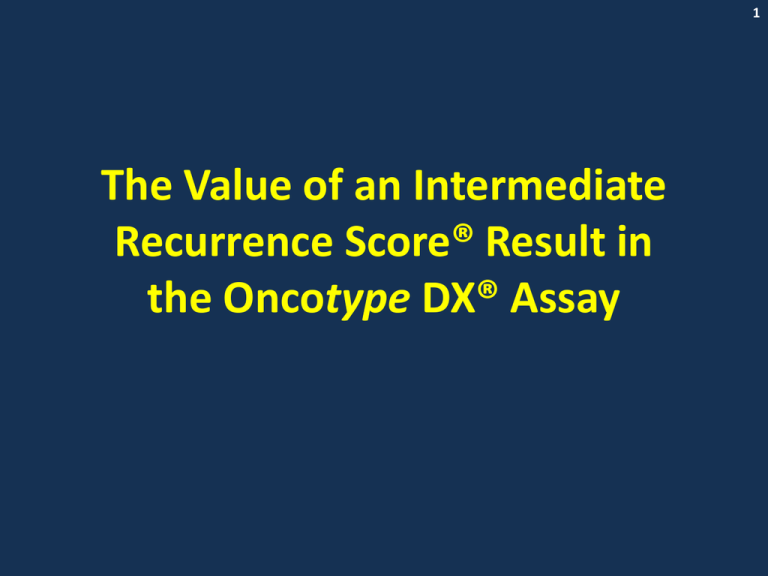
1
The Value of an Intermediate
Recurrence Score® Result in
the Oncotype DX® Assay
2
Does an Oncotype DX®
Recurrence Score® result in the
intermediate range (18-30) provide
value in treatment decision-making?
The Intermediate Oncotype DX®
Recurrence Score® Result
Factors in Medical Decision-making
The Prognostic Value of the Oncotype DX Assay
Across All Risk Groups
The Predictive Value of the Oncotype DX Assay
Across All Risk Groups
Case 1: Components of a
Complex Treatment Decision
The Oncotype DX Recurrence Score Result
Reinforces the Treatment Decision
Case 2: Treatment Decision Based on
Many Factors
TAILORx Study: Refining Estimations of Risk/Benefit of
Adjuvant Treatment Options
3
4
Intermediate test results are part of
the continuous nature of biology
Treatment Decision
Test Result Information
Type of Test Result
Evaluation of hypertension
Level of systolic and diastolic
blood pressure
Continuous scale
Evaluation for prostate cancer
Level of serum PSA
Continuous scale
Evaluation of cholesterol level
Level of serum LDL cholesterol
Continuous scale
PSA, prostate-specific antigen; LDL, low-density lipoprotein
5
Many factors contribute to treatment decisions
for patients of “intermediate” risk
LDL cholesterol (measured on a continuous scale)
< 100 mg/dL
100-160 mg/dL
> 160 mg/dL
Risk of cardiovascular event (continuum of risk)
Low
Intermediate
High
Other risk factors for cardiovascular event
No statin
therapy
• Blood pressure
• Family history
• Smoking history
• Diabetes
Statin
therapy
6
Many factors weigh into the adjuvant
treatment decision in breast cancer
Recurrence Score® value 18-30
•
•
•
•
•
•
•
Small tumor size
Low tumor grade
Patient old age
Patient co-morbidities
Patient preference
Oncotype DX® Recurrence Score value
Degree of ER expression
Hormonal therapy only
Paik S, et al. ASCO. 2005; Abstract 510.
•
•
•
•
•
•
•
Large tumor size
High tumor grade
Patient young age
Patient good health
Patient preference
Oncotype DX Recurrence Score value
Degree of ER expression
Chemotherapy +
hormonal therapy
The Intermediate Oncotype DX®
Recurrence Score® Result
Factors in Medical Decision-making
The Prognostic Value of the Oncotype DX Assay
Across All Risk Groups
The Predictive Value of the Oncotype DX Assay
Across All Risk Groups
Case 1: Components of a
Complex Treatment Decision
The Oncotype DX Recurrence Score Result
Reinforces the Treatment Decision
Case 2: Treatment Decision Based on
Many Factors
TAILORx Study: Refining Estimations of Risk/Benefit of
Adjuvant Treatment Options
7
8
Distribution of Recurrence Score® results in US clinical
practice shows that 52% of patients are low-risk
N = 101,960
13%
52%
35%
RS <18
Palmer G, et al. ECCO-ESMO 2009; abstract 194.
RS 18-30
RS ≥31
Data collected between January 2004 and April 2009.
9
Oncotype DX® Recurrence Score® result has
prognostic and predictive clinical value
HIGHER RISK
Distant Recurrence at 10 Years
LOWER RISK
Recurrence Score
The lower the Recurrence Score value:
• The lower the risk of distant recurrence
• The lower the benefit of chemotherapy
• The greater the benefit of tamoxifen
The higher the Recurrence Score value:
• The greater the risk of distant recurrence
• The greater the benefit of chemotherapy
Paik S, et al. N Engl J Med. 2004;351:2817. Paik S, et al. J Clin Oncol. 2006;24:3726. Habel LA, et al. Breast Cancer Res. 2006;8:R25.
10
Clinical validation of the Oncotype DX® assay:
Risk groups defined for distant recurrence
Proportion Without Distant Recurrence
NSABP B-14
100%
90%
80%
P < 0.001
70%
60%
50%
40%
n (%)
10-Year Rate
of Recurrence
95% CI
30%
Risk Group
20%
Low (RS < 18)
338 (51)
6.8%
4.0%, 9.6%
Intermediate (RS 18-30)
149 (22)
14.3%
8.3%, 20.3%
High (RS ≥ 31)
181 (27)
30.5%
23.6%, 37.4%
10%
0%
0
Paik S, et al. N Engl J Med. 2004;351:2817.
2
4
6
8
Years
10
12
14
16
RS, Recurrence Score® result
The Intermediate Oncotype DX®
Recurrence Score® Result
Factors in Medical Decision-making
The Prognostic Value of the Oncotype DX Assay
Across All Risk Groups
The Predictive Value of the Oncotype DX Assay
Across All Risk Groups
Case 1: Components of a
Complex Treatment Decision
The Oncotype DX Recurrence Score Result
Reinforces the Treatment Decision
Case 2: Treatment Decision Based on
Many Factors
TAILORx Study: Refining Estimations of Risk/Benefit of
Adjuvant Treatment Options
11
12
Myth vs Fact: The Intermediate
Recurrence Score® Group
Myth
Fact
Intermediate Oncotype DX®
Recurrence Score value
doesn’t provide any
information regarding
a treatment
recommendation.
Intermediate Oncotype DX
Recurrence Score value
does provide information
about the likely response
of patients to adjuvant
hormonal therapy and
adjuvant chemotherapy.
The Oncotype DX® assay identifies patients for whom
tamoxifen alone may be appropriate therapy
(NSABP B-14)
Recurrence Score® value
< 18
≥ 31
18-30
NO SYSTEMIC
TREATMENT
Tamoxifen
benefit
Tamoxifen benefit
TAMOXIFEN
0
5
10
15
20
25
30
35
10-Year Absolute Risk BC Death (%) (95% CI)
Paik S, et al. ASCO. 2005; Abstract 510.
40
13
14
The Oncotype DX® assay can predict benefit from
chemotherapy and tamoxifen (NSABP B-20)
Recurrence Score® value
< 18
≥ 31
18-30
TAMOXIFEN
Chemotherapy benefit
TAMOXIFEN
+ CHEMO
0
5
10
15
20
25
30
35
10-Year Absolute Risk BC Death (%) (95% CI)
Adapted from Paik S, et al. J Clin Oncol. 2006;24:3726.
40
The Intermediate Oncotype DX®
Recurrence Score® Result
Factors in Medical Decision-making
The Prognostic Value of the Oncotype DX Assay
Across All Risk Groups
The Predictive Value of the Oncotype DX Assay
Across All Risk Groups
Case 1: Components of a
Complex Treatment Decision
The Oncotype DX Recurrence Score Result
Reinforces the Treatment Decision
Case 2: Treatment Decision Based on
Many Factors
TAILORx Study: Refining Estimations of Risk/Benefit of
Adjuvant Treatment Options
15
16
Case 1: Should this patient receive
adjuvant chemotherapy?
Patient MP (65 years old)
Medical History
• Compensated congestive heart failure
• “Silent” myocardial infarction
4 years ago
• Type 2 diabetes well controlled
with oral therapy
Physical Exam
• No symptoms climbing 1 flight
of stairs
• Healing well from recent lumpectomy
and sentinel node biopsy
• Patient anxious and fearful of
breast cancer, wants “strongest
chemotherapy”
Characteristic
Result
Tumor size
1.8 cm
Tumor grade
1
Lymph nodes
2 sentinel nodes negative
ER/PR status
ER+/PR+
HER2 status
Negative
Oncotype DX®
Recurrence Score®
25
• Patient MP wants to have adjuvant
chemotherapy, but her co-morbidities could
make chemotherapy a difficult course.
• Could the potential risks of chemotherapy
outweigh the benefits?
• Can the Oncotype DX Recurrence Score result
be used to inform adjuvant treatment
decisions?
17
Case 1: What does the Oncotype DX®
Recurrence Score® tell us about this patient?
RESULTS
Recurrence Score =
25
CLINICAL EXPERIENCE
Patients with a Recurrence Score of 25 in clinical validation study had an Average Rate of
Distant Recurrence at 10 years of 16.2% (95% CI: 12.6%, 19.8%)
18
Case 1: Single-gene results suggest high
likelihood of benefit from tamoxifen
PATIENT REPORT
Patient: MP
Sex: Female
DOB: 06/17/1944
Requisition: A0000B
Order Received: 02/01/2009
Date Reported: 02/13/2008
QUANTITATIVE HORMONE RECEPTOR ANALYSIS
The Oncotype DX assay uses RT-PCR to determine the RNA expression of the hormone receptor genes below. These results may differ from ER
or PR results reported using other methods or reported by other laboratories. 1
The ER Score and the PR Score are also included in the calculation of the Recurrence Score.
ER Score =
11.0
Positive
The ER Score positive/negative cut-off of 6.5 units was validated from a study of 761 samples using the 1D5 antibody (immunohistochemistry)
and 607 samples using the SP1 antibody (immunohistochemistry). The standard deviation for the ER Score is less than 0.5 units.2
Clinical Experience:
For ER positive breast cancer, the magnitude of tamoxifen benefit increases as the ER Score increases from 6.5 to ≥ 12.5. 3
Please note: The Average Rate of Distant Recurrence reported on Page 1 based on the Recurrence Score was determined in patients who
received 5 years of tamoxifen treatment and takes into account the magnitude of tamoxifen benefit indicated by the ER Score.
PR Score =
9.1
Positive
The PR Score positive/negative cut-off of 5.5 units was validated from a study of 761 samples using the PR636 antibody (immunohistochemistry)
and another study of 607 samples using the PR636 antibody (immunohistochemistry). The standard deviation for the PR Score is less than 0.5
units.2
References:
1. ER Score based on quantitative ESR1 expression (estrogen receptor); PR Score based on quantitative PGR expression (progesterone receptor).
2. ASCO Breast Cancer Symposium 2007 Abstracts #87 by S.S. Badve et al., and #88 by F.L. Baehner et al.
3. ASCO Annual Meeting 2005 Abstract #510 by S. Paik et al.
19
Case 1: Multiple factors to consider in the
adjuvant treatment decision
Oncotype DX® Recurrence Score® value (measured on a continuous scale)
< 18
18-30
≥ 31
Intermediate
High
Distant recurrence (continuum of risk)
Low
Hormonal
therapy
only
Favor no chemotherapy
• Smaller tumor/lower
grade
• Diabetes
• Congestive heart failure
• Coronary artery disease
• Degree of ER expression
Favor chemotherapy
• Larger tumor/higher
grade
• Extreme anxiety of
cancer recurrence
Hormonal
therapy
plus
chemotherapy
20
Case 1: Low risk of recurrence
reduces patient fears
• Upon hearing the results of the Oncotype DX® assay
and the predicted 10-year risk of distant recurrence
of 16%, Patient MP is reassured and feels more
comfortable with hormonal therapy without
chemotherapy.
• After discussing the risks and benefits of
chemotherapy, she opts for adjuvant hormonal
therapy alone.
The Intermediate Oncotype DX®
Recurrence Score® Result
Factors in Medical Decision-making
The Prognostic Value of the Oncotype DX Assay
Across All Risk Groups
The Predictive Value of the Oncotype DX Assay
Across All Risk Groups
Case 1: Components of a
Complex Treatment Decision
The Oncotype DX Recurrence Score Result
Reinforces the Treatment Decision
Case 2: Treatment Decision Based on
Many Factors
TAILORx Study: Refining Estimations of Risk/Benefit of
Adjuvant Treatment Options
21
22
Both clinicians and patients find the Oncotype DX®
assay helped with adjuvant treatment decisions
Parameter
% of
Respondents
Medical oncologists (N = 16) who:
• Reported increased confidence in treatment recommendation
• Felt the Recurrence Score® result provided additional information
• Felt the Recurrence Score result influenced treatment recommendation
93.8
93.8
87.6
Patients (N = 67) who:
• Were glad (at 12 months) that they used the Oncotype DX assay
• Found assay results easy to understand
• Felt the assay influenced treatment decision
• Were satisfied with their adjuvant treatment decision
92.5
89.6
80.6
95.5
Lo SS, et al. J Clin Oncol. 2010; 28:1671-1676. Lo SS et al. SABCS 2008: Abstract 3113.
The Intermediate Oncotype DX®
Recurrence Score® Result
Factors in Medical Decision-making
The Prognostic Value of the Oncotype DX Assay
Across All Risk Groups
The Predictive Value of the Oncotype DX Assay
Across All Risk Groups
Case 1: Components of a
Complex Treatment Decision
The Oncotype DX Recurrence Score Result
Reinforces the Treatment Decision
Case 2: Treatment Decision Based on
Many Factors
TAILORx Study: Refining Estimations of Risk/Benefit of
Adjuvant Treatment Options
23
24
Case 2: Is adjuvant chemotherapy the
right treatment option for this patient?
Patient JD (54 years old)
• Referred to you for adjuvant
treatment
Medical History
• Unremarkable
• Menopause 4 years ago
Physical Exam
• Underwent a lumpectomy for
adenocarcinoma and sentinel
node sampling 2 weeks prior
• Healing left breast and axillary
wounds
• Otherwise unremarkable
• Patient JD is concerned about
recurrence risk but is also fearful
of the potentially disruptive effect
chemotherapy may have on her life.
Characteristic
Result
Tumor size
1.1 cm
Tumor grade
2
Lymph nodes
3 sentinel nodes negative
ER/PR status
ER+/PR+
HER2 status
Negative
Oncotype DX®
Ordered, but results not yet returned
• Does Patient JD need chemotherapy?
• What can the Oncotype DX Recurrence Score®
result reveal about her recurrence risk?
25
Case 2: A Recurrence Score® result of 30 is
on the high end of the intermediate range
RESULTS
Recurrence Score =
30
CLINICAL EXPERIENCE
Patients with a Recurrence Score of 30 in clinical validation study had an Average Rate of
Distant Recurrence at 10 years of 20.0% (95% CI: 15.4%, 24.4%)
26
Case 2: Single-gene results suggest low
likelihood of benefit from tamoxifen
PATIENT REPORT
Patient: JD
Sex: Female
DOB: 05/17/1955
Requisition: A1111B
Order Received: 03/01/2009
Date Reported: 03/13/2008
QUANTITATIVE HORMONE RECEPTOR ANALYSIS
The Oncotype DX assay uses RT-PCR to determine the RNA expression of the hormone receptor genes below. These results may differ from ER
or PR results reported using other methods or reported by other laboratories. 1
The ER Score and the PR Score are also included in the calculation of the Recurrence Score.
ER Score =
7.0
Positive
The ER Score positive/negative cut-off of 6.5 units was validated from a study of 761 samples using the 1D5 antibody (immunohistochemistry)
and 607 samples using the SP1 antibody (immunohistochemistry). The standard deviation for the ER Score is less than 0.5 units.2
Clinical Experience:
For ER positive breast cancer, the magnitude of tamoxifen benefit increases as the ER Score increases from 6.5 to ≥ 12.5. 3
Please note: The Average Rate of Distant Recurrence reported on Page 1 based on the Recurrence Score was determined in patients who
received 5 years of tamoxifen treatment and takes into account the magnitude of tamoxifen benefit indicated by the ER Score.
PR Score =
6.0
Positive
The PR Score positive/negative cut-off of 5.5 units was validated from a study of 761 samples using the PR636 antibody (immunohistochemistry)
and another study of 607 samples using the PR636 antibody (immunohistochemistry). The standard deviation for the PR Score is less than 0.5
units.2
References:
1. ER Score based on quantitative ESR1 expression (estrogen receptor); PR Score based on quantitative PGR expression (progesterone receptor).
2. ASCO Breast Cancer Symposium 2007 Abstracts #87 by S.S. Badve et al., and #88 by F.L. Baehner et al.
3. ASCO Annual Meeting 2005 Abstract #510 by S. Paik et al.
27
Case 2: Multiple factors to consider in the
adjuvant treatment decision
Oncotype DX® Recurrence Score® value (measured on a continuous scale)
< 18
18-30
≥ 31
Distant recurrence (continuum of risk)
Low
Hormonal
therapy
only
Intermediate
Favor no chemotherapy
• Smaller tumor/lower
grade
• Patient fear of life
disruption by chemo
Favor chemotherapy
• Larger tumor/higher
grade
• Patient age
• Patient good health
• Degree of ER
expression
High
Hormonal
therapy
plus
chemotherapy
28
Case 2: Recurrence risk and patient characteristics
factor into adjuvant chemotherapy decision
• Patient JD understands her Recurrence Score® result
of 30 means she has a substantial chance of
recurrence of breast cancer in 10 years.
• Because of the tumor grade, her relatively young
age, and her good health, Patient JD decides to have
adjuvant chemotherapy followed by hormonal
therapy.
29
The full range of Oncotype DX® results provides
useful information to guide treatment decisions
• The Oncotype DX Recurrence Score® value provides a
scientifically validated continuous measure of risk of
distant recurrence and magnitude of chemotherapy
benefit.
• Even when the Oncotype DX Recurrence Score® value is
in the intermediate zone, the assay results provide
information that, together with other clinical
information, can help guide treatment decisions.
• The Oncotype DX Recurrence Score result allows an
individualized assessment of risk and response to
therapy, which contributes to making more informed
treatment decisions for individual patients.

